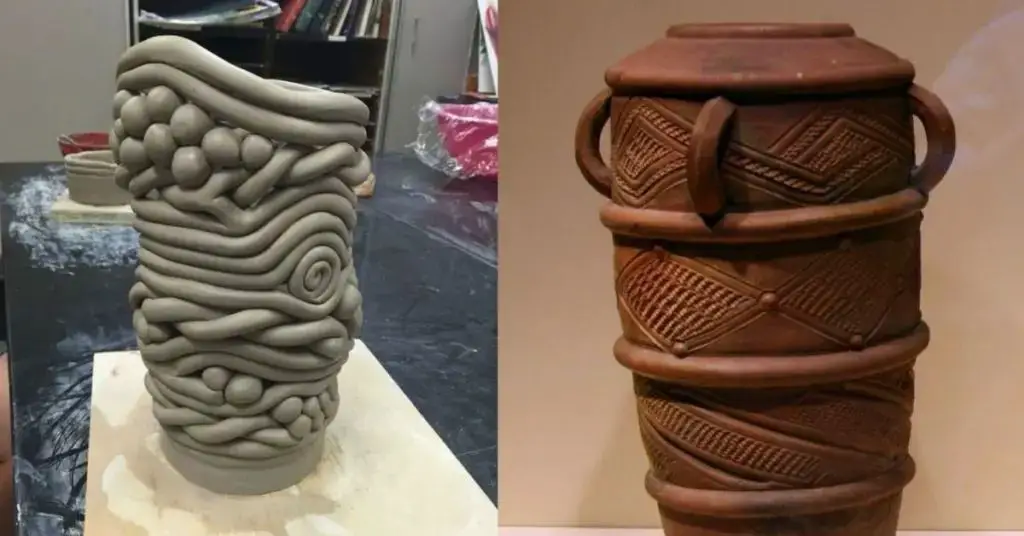What Can I Use Instead Of A Pottery Wheel?
A pottery wheel is a machine used in the shaping of round ceramic ware. It enables the efficient production of consistently shaped articles. The potter’s wheel is an essential tool used throughout history for throwing pots, bowls, plates, and other circular or rotational items out of clay.
The pottery wheel uses a rotating horizontal platform, or “head”, to shape wet clay into symmetrical forms. The potter uses their hands, tools, and gravity to manipulate and form the clay as the wheel spins. The centrifugal force provided by the spinning helps shape and raise the clay. Using a pottery wheel allows a potter to quickly and uniformly produce simple forms like bowls, cups, and vases which can then be trimmed and modified after drying.
Pottery wheels allow potters to create significantly more precise pieces than they could sculpting by hand alone. The symmetry and consistency achieveable on the wheel enables mass production of ceramics and is both faster and more ergonomic than alternative shaping techniques.
Alternatives that Spin
One of the most accessible alternatives to an electric pottery wheel is a manual kick wheel. Kick wheels provide the spinning motion needed to throw clay on the wheel through foot power rather than electricity. They have a kick plate that you pump with your foot to generate momentum. This allows you to use the centrifugal force of a spinning wheel without electricity.
Kick wheels like the ones made by Creative Industries [1] or sold on sites like eBay [2] offer an affordable and practical alternative to electric wheels. They provide enough spinning power for most throwing needs at a fraction of the cost of motorized wheels. With practice, you can center and throw clay on a kick wheel just as you would with an electric one.
Alternatives that Don’t Spin
Handbuilding techniques are great alternatives for making pottery without a wheel. These techniques allow you to shape and construct clay pieces completely by hand, without any spinning mechanism.
Pinch pots are one of the most basic handbuilding techniques. To make a pinch pot, you take a ball of clay and use your fingers and thumbs to pinch and shape it into a simple pot form. Pinch pots are easy to make and great for beginners.
Another handbuilding approach is coil building. With this method, you roll out and stack coils of clay on top of each other to build up vessel forms. Coiling allows you to make larger and more complex shaped pieces.

Slab building is also very versatile. This involves rolling out flat clay slabs that can then be cut, stacked, and joined together. Slab pots often have angular shapes and interesting surface textures.
With handbuilding, the limits are your imagination. And without the need for a pottery wheel, it’s an accessible way for anyone to start making ceramic vessels and sculpture.
Improvised Spinning Surfaces
If you don’t have a proper pottery wheel, you can improvise with household objects that spin to mimic the wheel’s rotating surface. Some popular improvised spinning surfaces include:
Record Players
Old record players can substitute for a potter’s wheel. Place a bat or pottery plaster over the turntable, then center your clay on top and use the power switch to control the spinning speed. The size of the turntable provides a decent surface area to throw medium sized pots. Just be mindful of the needle arm and use gentle pressure when shaping to avoid damaging the player. Source
Lazy Susans
A lazy susan offers an easy improvised surface to handbuild or throw small pots on. Place the lazy susan on a steady work surface, then center your clay and rotate it manually to mimic a wheel while shaping. The bearing allows smooth, consistent spinning. Look for larger lazy susans to provide more space.
Cake Turntables
Cake turntables designed for decorating cakes are another handy improvised pottery wheel alternative. They provide a diameter of around 10 inches for throwing small pieces. Simply place the turntable on a non-slip mat, center your clay, and rotate smoothly by hand as you shape the pot.
Manual Techniques
Throwing clay without a wheel is possible using manual techniques that rely on your hands, simple tools, and some creativity. The basic process involves wedging or kneading the clay to the desired consistency, then using hands and tools to shape it as it rests on a flat surface. Here are some common handbuilding techniques to shape clay without a wheel:
Pinching: Pinching clay between your fingers and thumbs allows you to draw up vertical walls from a solid base. It’s great for making simple bowls, cups, and vases. Using metal ribs can help refine the shape and smooth surfaces.
Coiling: Rolling out and stacking long coils or ropes of clay is a method to build taller, unsupported forms. Blend the coils together using water and tools. Let gravity work for you as new coils are added.
Slab building: Rolling out flat clay sheets or slabs enables constructing box and geometric shapes. Cut slabs using wire or fettling knives and join them using slip. Cut outs and textures can add interest.
While manual techniques take practice and time, the unlimited freedom of hand building without a wheel can lead to truly original, organic works. Patience and experimentation is key.
Considerations
When choosing an alternative to a traditional pottery wheel, there are a few key considerations to keep in mind:
Space Constraints – Some alternatives like improvised spinning surfaces or kick wheels take up less space than an electric wheel. This is ideal if you have limited workspace. However, options like modified drills or manual techniques don’t require any additional equipment so are the most space-saving.
Cost – Improvised and manual options are very low cost or free. Kick wheels are the most budget-friendly powered option. Electric wheels range widely in price but expect to pay $300+ for a decent beginner’s wheel. High-end wheels can cost over $1000 (Source).
Type of Pottery – Modifications like drills or improvised surfaces can only handle small pieces. Kick wheels allow medium vessels. Electric wheels give the versatility for small or large work. Consider what you want to make when choosing (Source).
Tips and Tricks
Centering clay properly is crucial for achieving smooth spinning and preventing wobbling. Here are some tips for centering clay without a pottery wheel:
- Start with a ball of clay that has been wedged thoroughly to remove air bubbles.
- Place the ball of clay on your improvised spinning surface and apply downward pressure with both thumbs on top while supporting the bottom. Rotate slowly while applying even pressure.
- Aim to center the clay both horizontally and vertically. Check for wobbling by taking your hands away – any wobbling means it needs more centering.
- Add water sparingly if the clay starts to drag. Too much water will soften the clay and make centering more difficult.
When finished with handbuilding or sculpting, refine the surfaces by gently smoothing with a metal rib or soft rubber tool. Use a damp sponge to erase fingerprints and remove dust before drying and firing your piece.
With practice and patience, you can create beautiful handbuilt pottery without ever needing a pottery wheel! Focus on proper technique and allow your creativity to shine through in the finished pieces.
Inspiration
There are many stunning examples of handbuilt pottery that can serve as inspiration when creating clay pieces without a pottery wheel. Coil building, pinching, and slab construction allow for intricate shapes and detailed surface textures.
Some beautiful coil built vessels include the intricate patterns in this geometric piece from Brenda Ellis. The coils are visible but blended smoothly. Large pitchers and vases like this tall textured piece demonstrate the scale possible with coil building.
Pinch pots allow organic, hand-shaped forms like these burnished and glazed bowls from ceramic artist Lizella Lobmeyer. The indentations and wrinkles left by pinching remain part of the charm.
Slab built boxes, plates, and sculptures often feature perfect ninety-degree angles and flat surfaces not possible on the wheel. The geometric patterns on this rectangular slab sculpture are an example.
These handbuilt pieces prove clay can be sculpted into beautiful, functional wares without ever touching a pottery wheel.
Resources
If you want to pursue making pottery without a wheel, here are some recommended tools, materials, and tutorials to help get you started:
For tools, a basic pottery tool kit is essential. This includes things like: pottery needles, loop tools, ribs, sponges, trimming tools, etc. Pick up an inexpensive starter set to begin (Source).
As for materials, you’ll need clay and glazes. For clay, try an air-dry clay to start or low-fire earthenware clays that can be fired in a regular oven. For glazes, look for low-fire glazes that match the type of clay you’re using (Source).
Check out online video tutorials on YouTube and Instagram for step-by-step guidance on handbuilding techniques like pinch pots, coil pots, slab building, etc. Experienced potters generously share their knowledge (Source).
Conclusion
Pottery doesn’t have to involve a traditional wheel. Although a wheel provides the spinning motion that makes many pottery techniques easier, it is possible to handbuild or throw pottery using alternatives. With a little creativity and practice, tools like salad spinners, banding wheels, kickwheels, or simple turntables can provide a spinning motion for modeling clay. Even without any kind of spinning, clay can be shaped completely by hand using methods like pinch pots, coils, slabs, and sculpting. While handbuilding takes more time and practice, it allows for greater creativity and custom shapes. With the right tools, techniques, and imagination, beautiful pottery can be created without ever using a standard wheel.




